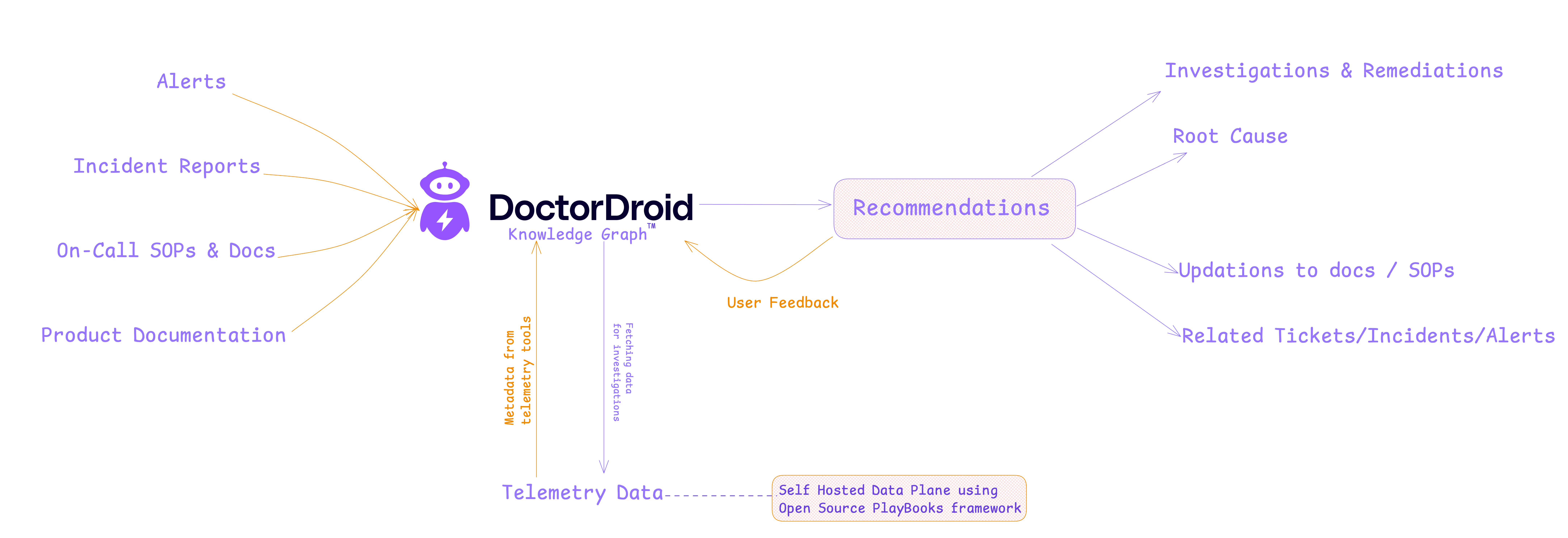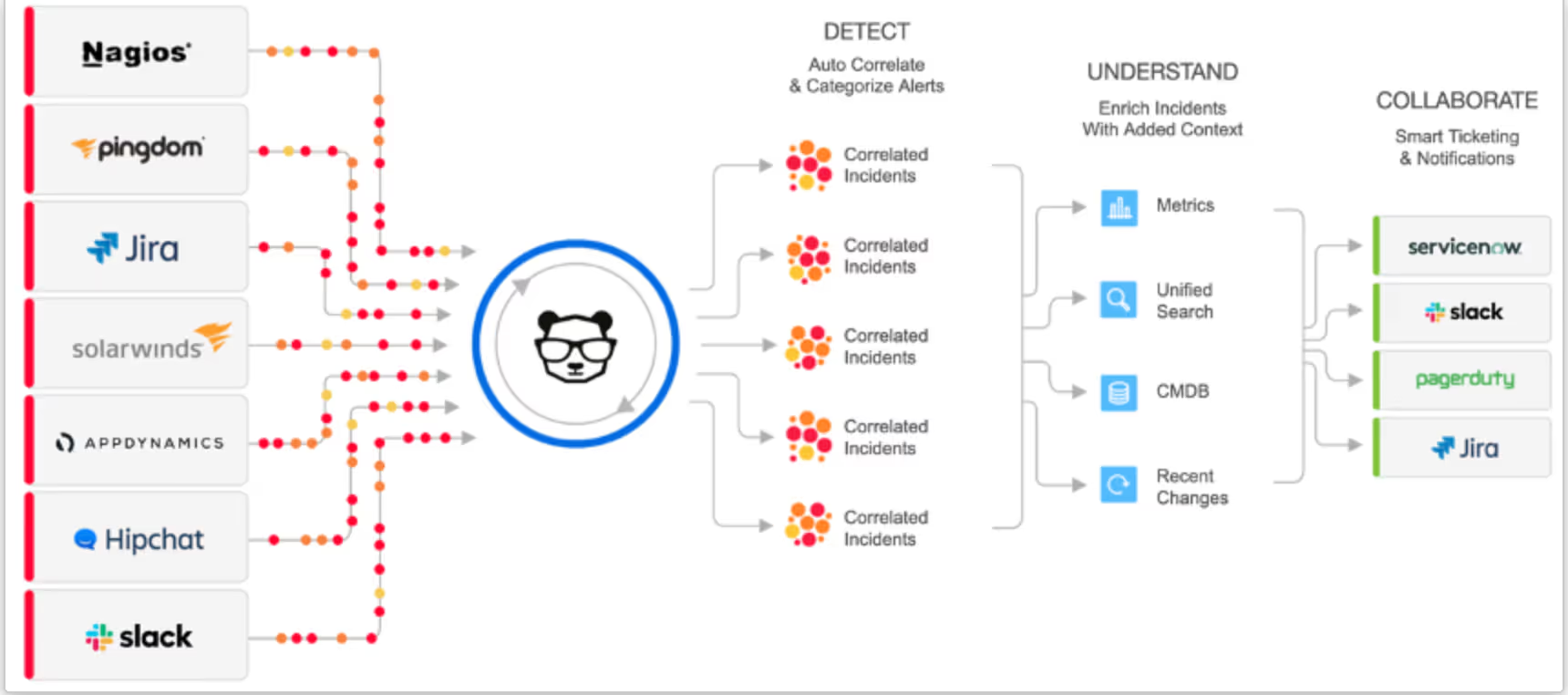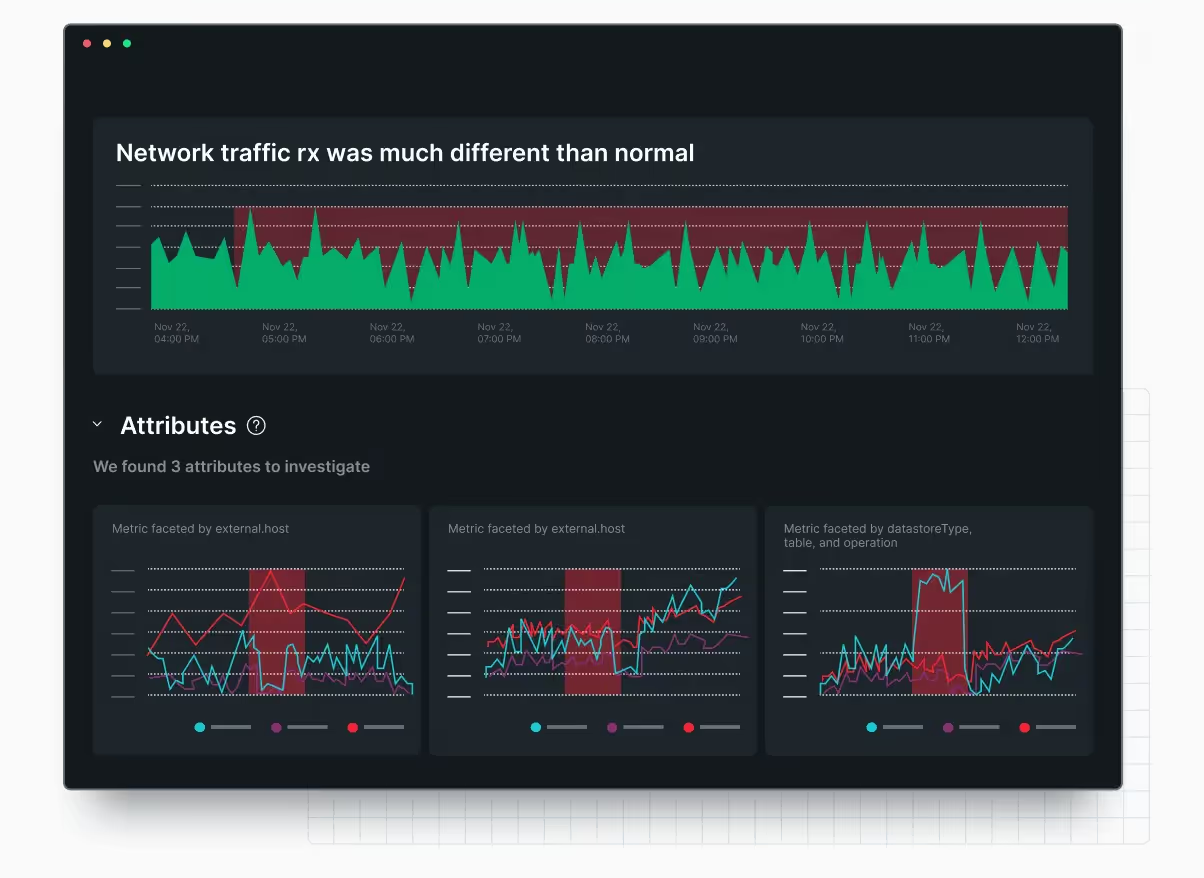AIOps, short for Artificial Intelligence for IT Operations, represents a revolutionary approach to managing the complexity of modern engineering & IT environments. It's the clever fusion of artificial intelligence (AI) and machine learning (ML) with traditional IT operations, creating a smarter, more responsive way to handle the challenges of our digital infrastructure.
Imagine having a super-intelligent assistant that never sleeps, constantly watching over your IT systems, learning from every hiccup and triumph, and getting better at predicting and solving problems over time. That's the essence of AIOps.
At its core, AIOps is about leveraging the power of AI and ML to:
By implementing AIOps, organizations can significantly reduce the manual workload on IT teams, accelerate problem resolution, and improve the overall reliability and performance of their systems. It's not about replacing human expertise, but rather augmenting it, allowing IT professionals to focus on more strategic initiatives while AI handles the day-to-day heavy lifting.
In a world where our reliance on digital systems is ever-growing, and the complexity of these systems is increasing exponentially, AIOps isn't just a nice-to-have – it's becoming a necessity for organizations that want to stay competitive and ensure smooth operations in the digital age.
1. Reducing Alert Fatigue through Alert Grouping:
In today's complex IT environments, alert fatigue is a real problem. IT teams are often bombarded with thousands of alerts daily, many of which may be redundant or non-critical. AIOps tackles this issue head-on:
2. Getting to Root Cause Faster Using AI:
When an incident occurs, time is of the essence. AIOps accelerates the troubleshooting process:
3. Automated Anomaly Detection Using ML Techniques:
Detecting issues before they become critical is a game-changer for IT operations:
These use-cases demonstrate how AIOps is not just about automating existing processes, but about transforming the way IT operations are managed. By leveraging AI and ML, organizations can move from a reactive to a proactive stance, addressing issues faster, reducing downtime, and ultimately delivering a better experience for both IT teams and end-users.
When evaluating AIOps tools, it's crucial to consider several key features that can make a significant difference in the tool's effectiveness and ease of implementation. Here are some important aspects to consider:
Remember, the goal of AIOps is to simplify and improve IT operations. The right tool should reduce your workload, not add to it. By considering these features, you can choose an AIOps solution that truly enhances your IT operations and provides value quickly and consistently.

The Doctor Droid AIOps Platform builds a knowledge graph using company data to give investigation & remediation recommendations during on-call issues & incidents. 1. Accessibility and Immediate Value: Doctor Droid stands out by making AIOps accessible to teams of all sizes. Unlike many enterprise solutions that require significant upfront investment and company-wide adoption, Doctor Droid offers value from day one. This approach allows individual engineering teams to adopt advanced AIOps capabilities without waiting for enterprise-level decisions or investments. 2. Knowledge Graph Technology: At the core of Doctor Droid's platform is its knowledge graph generator. This sophisticated system ingests and analyzes various data sources to build a comprehensive understanding of your IT environment. It's like creating a detailed map of your entire IT ecosystem, showing how everything is interconnected. Sources it uses include: - Past incident reports - Issue tickets from systems like JIRA - On-call playbooks and SOPs - Service documentation - Historical alert data By analyzing these sources, Doctor Droid can understand the patterns of incidents, the relationships between different components, and the typical actions taken to resolve issues.
.avif)
This real-time capability is like having an AI assistant that instantly understands the context of an issue and can guide you towards the most effective solution.
Reduce Alert Fatigue with noisy alert visibility & new alert recommendations.
.avif)
.avif)
Get recommendations for On-Call SOP updation:
In essence, Doctor Droid is democratizing access to advanced AIOps capabilities. It's designed to grow with your team, leveraging your existing knowledge and data to provide immediate benefits while continuously improving its understanding and recommendations over time. This approach makes it an attractive option for teams looking to enhance their operational intelligence without the barriers often associated with enterprise AIOps solutions.

BigPanda is a leader in AIOps, focusing on event correlation and automation. Their platform is designed to help IT Ops, NOC, and DevOps teams detect, investigate, and resolve IT incidents faster. BigPanda's core strength lies in its Open Box Machine Learning technology, which provides transparent and explainable AI-driven insights.
One of BigPanda's standout features is its ability to create a real-time topology map of your IT environment. This map helps visualize the relationships between different components and services, making it easier to understand the impact of incidents. Additionally, BigPanda offers robust automated incident management and response capabilities, allowing teams to set up workflows that can automatically trigger actions based on specific events or conditions.
BigPanda's core strength lies in its ability to correlate events across complex IT environments. Its Open Box Machine Learning technology provides transparent insights, allowing users to understand how the AI makes decisions. This transparency is crucial for teams that need to trust and verify AI-driven recommendations.
The platform's real-time topology mapping is a standout feature, visualizing the relationships between different IT components. This mapping helps teams quickly understand the impact and spread of incidents across their infrastructure. BigPanda's automated incident management capabilities allow teams to set up sophisticated workflows, automating responses to specific events or conditions.
BigPanda is particularly well-suited for large enterprises with complex, multi-faceted IT environments. Its ability to handle high volumes of alerts and intelligently group related issues makes it valuable for organizations struggling with alert fatigue and looking to streamline their incident response processes.

Moogsoft is an AIOps and observability platform that caters primarily to DevOps and SRE teams. Their focus is on delivering continuous service assurance through AI-driven insights and automation. Moogsoft's anomaly detection and correlation capabilities are particularly noteworthy, able to identify unusual patterns across diverse data streams and link related events. A unique feature of Moogsoft is its collaborative virtual war rooms. These spaces allow teams to come together in real-time to address critical incidents, with all relevant data and insights at their fingertips.
Moogsoft's AIOps platform is designed with a focus on DevOps and Site Reliability Engineering (SRE) teams. Its core strength lies in its ability to detect anomalies and correlate events across a wide range of data sources, helping teams identify potential issues before they escalate into major problems.
Moogsoft's integration capabilities are another strong point. The platform integrates seamlessly with popular collaboration tools like Slack and Microsoft Teams, as well as various monitoring and ticketing systems. This makes it easier for teams to incorporate Moogsoft into their existing workflows without significant disruption.

Known for incident response, now expanded into AIOpsOffers intelligent alert grouping and automated incident triageProvides real-time situational awareness toolsPagerDuty has evolved from an incident response platform to incorporate significant AIOps capabilities. Its intelligent alert grouping and noise reduction features help teams cut through the clutter and focus on the most critical issues, addressing the common problem of alert fatigue in IT operations. PagerDuty's real-time situational awareness tools provide teams with a holistic view of ongoing incidents and their potential impact on services. This overview helps teams prioritize their efforts and understand the broader context of issues they're dealing with. PagerDuty is particularly well-suited for organizations that need to manage complex on-call schedules and want to improve their incident response times.

Datadog's AIOps capabilities are deeply integrated into its broader monitoring and analytics platform, offering a unified solution for observability and operational intelligence. One of Datadog's standout features is its ability to perform anomaly detection across metrics, logs, and traces, providing a comprehensive view of system behavior and potential issues.
Datadog's AIOps capabilities are deeply integrated into its comprehensive monitoring and analytics platform. This integration allows for seamless correlation between different types of data, providing a holistic view of system behavior. The platform's ability to perform anomaly detection across metrics, logs, and traces is particularly powerful, enabling teams to spot unusual patterns that might be missed by traditional monitoring approaches.
One of Datadog's standout features is its automated root cause analysis. This capability helps teams quickly pinpoint the source of problems in complex, distributed systems, significantly reducing mean time to resolution (MTTR). The platform's predictive alerting and forecasting capabilities leverage machine learning to anticipate potential issues before they impact users, allowing for proactive problem-solving.
Datadog's AIOps solution is well-suited for organizations that are already using or considering Datadog for their monitoring needs. Its unified approach to observability and AIOps can be particularly beneficial for teams looking to consolidate their tooling and gain deeper insights from their operational data.

Dynatrace offers a comprehensive AIOps solution as part of its Software Intelligence Platform. Features Davis, an AI engine using causation-based AI for root cause analysis Offers automatic discovery and mapping of all components and dependencies Provides powerful automation capabilities for problem resolution At the heart of Dynatrace's AIOps offering is Davis, its AI engine that uses causation-based AI for precise root cause analysis. Unlike correlation-based approaches, Davis aims to understand the actual cause-and-effect relationships in IT environments, leading to more accurate and actionable insights. This can be particularly valuable in complex, microservices-based architectures where traditional approaches may fall short. Dynatrace's ability to automatically discover and map all components and dependencies in an IT ecosystem is another key strength. This real-time application and infrastructure topology makes it easier to understand the context of any issue and its potential impact. It's particularly useful for teams dealing with dynamic, rapidly changing environments. The platform also offers powerful automation capabilities, allowing teams to set up automated problem resolution workflows based on AI-driven insights. This can significantly reduce the manual workload on IT teams and speed up incident resolution. Dynatrace is well-suited for organizations that are already using Dynatrace and are looking for a comprehensive AIOps solution that can handle complex, dynamic IT environments with minimal manual configuration.

New Relic's AIOps capabilities are tightly integrated into its observability platform, offering a seamless experience for users already invested in the New Relic ecosystem.
The platform's proactive anomaly detection is a key feature, using machine learning to identify unusual patterns across a wide range of telemetry data. This can help teams spot potential issues before they escalate into major problems.
New Relic's AI-assisted incident diagnosis is another standout feature. It helps teams quickly understand the root cause of issues and their potential impact, speeding up the troubleshooting process. The platform's ability to automatically correlate related issues is particularly useful in complex environments, where a single root cause might manifest as multiple seemingly unrelated symptoms.
New Relic's approach to AIOps is focused on making it easier for teams to understand and act on the vast amounts of data generated by modern IT systems.
It's particularly well-suited for organizations that are already using New Relic for observability and want to leverage that data for more advanced, AI-driven insights and automation.

[Splunk Enterprise](https://www.splunk.com/en_us/software/splunk-enterprise/features.html) uses ML & AI with multi-site clustering with a platform to drive technology improvements within the firm. Splunk is a software application that enables end-users to gain real-time Operational Intelligence.
Businesses can use Splunk in different departments for:
The best part of this tool is that it supports log monitoring on multiple OS platforms. It provides the alerting based on the log information. This helps the organization check numerous anomalies in the systems.
This tool supports the next generation tool and cloud concept. It is imposing to continue monitoring the authentication and many more aspects. It can fetch the details through logs to find the one line among the hundreds of thousands of lines.
Splunk's AIOps solution is particularly well-suited for teams that are already using Splunk’s observability tool and need to derive insights from large volumes of diverse data and want to leverage a single platform for multiple IT operations use cases.
As we've explored these top AIOps platforms, it's clear that the field of AI-driven IT operations is rapidly evolving and offering powerful solutions to modern IT challenges. From BigPanda's event correlation to Doctor Droid's accessibility, each platform brings unique strengths to the table.
The rise of AIOps represents a significant shift in how organizations approach IT operations. By leveraging artificial intelligence and machine learning, these platforms are enabling IT teams to handle the increasing complexity of modern infrastructure with greater efficiency and insight. They're not just tools, but partners in managing the digital nervous systems of today's businesses.
When considering an AIOps solution, it's crucial to assess your organization's specific needs and capabilities:
Remember, the goal of AIOps is not to replace human expertise, but to augment it. The right platform should empower your team to work smarter, not harder. It should provide insights that would be impossible to glean manually, automate routine tasks, and free up your experts to focus on strategic initiatives.
As you explore these platforms, don't hesitate to take advantage of trials or demos. Hands-on experience can be invaluable in understanding how a tool will fit into your workflows.
The field of AIOps is still maturing, and we can expect to see continued innovation in the coming years. Whether you're just starting to explore AIOps or looking to upgrade your existing solutions, staying informed about the capabilities of these platforms will be crucial.
Ultimately, the right AIOps platform can transform your IT operations, leading to improved system reliability, faster incident resolution, and a more proactive approach to IT management. By carefully considering your options and choosing a solution that aligns with your needs, you can position your organization at the forefront of IT operations technology, ready to tackle the challenges of today's complex digital landscapes.
Try Doctor Droid — your AI SRE that auto-triages alerts, debugs issues, and finds the root cause for you.
(Perfect for DevOps & SREs)

Install our free slack app for AI investigation that reduce alert noise - ship with fewer 2 AM pings
Everything you need to know about Doctor Droid
AIOps (Artificial Intelligence for IT Operations) combines AI and machine learning with traditional IT operations to create smarter, more responsive infrastructure management. Unlike traditional IT operations that rely heavily on manual monitoring and intervention, AIOps analyzes vast amounts of data automatically, detects patterns, automates routine tasks, provides predictive insights, and offers optimization recommendations—essentially augmenting human expertise rather than replacing it.
The main benefits include reduced manual workload for IT teams, faster problem resolution, improved system reliability, automated routine tasks, predictive capabilities to prevent issues before they occur, intelligent optimization recommendations, and allowing IT professionals to focus on strategic initiatives rather than day-to-day troubleshooting.
Common use cases include anomaly detection in system performance, automated incident response, predictive maintenance of IT infrastructure, intelligent alert correlation and noise reduction, capacity planning, root cause analysis, service desk automation, and performance optimization across complex hybrid cloud environments.
Look for features such as machine learning capabilities, real-time monitoring and analytics, integration flexibility with your existing tools, automated incident response, anomaly detection, predictive analytics, root cause analysis, user-friendly dashboards, customizable alerts, and scalability to match your organization's growth.
Your organization might be ready if you're experiencing alert fatigue, managing increasingly complex infrastructure, struggling with manual processes, seeking more proactive IT management, have sufficient data sources for AI learning, possess technical capabilities to implement and maintain the solution, and have leadership support for the transformation.
Most top AIOps platforms offer pre-built integrations with common monitoring tools, ITSM systems, collaboration platforms, and infrastructure management solutions. They typically use APIs, webhooks, data collectors, and custom connectors to gather data from your existing ecosystem without requiring you to replace your current investments.
While both are leading AIOps platforms, BigPanda specializes in event correlation and automated incident management with a focus on reducing alert noise, while Moogsoft offers broader capabilities including anomaly detection, collaborative workflows, and situation management. Your choice might depend on whether you need focused alert correlation or a more comprehensive AIOps approach.
Yes, platforms like Doctor Droid are designed to be accessible to organizations of various sizes, offering more affordable entry points with simplified interfaces. Meanwhile, enterprise solutions like Splunk offer scalable approaches that can start small and grow. The key is matching the platform's complexity and cost with your organization's specific needs and technical capabilities.
Dr. Droid can be self-hosted or run in our secure cloud setup. We are very conscious of the security aspects of the platform. Read more about security & privacy in our platform here.
Dr. Droid can be self-hosted or run in our secure cloud setup. We are very conscious of the security aspects of the platform. Read more about security & privacy in our platform here.


